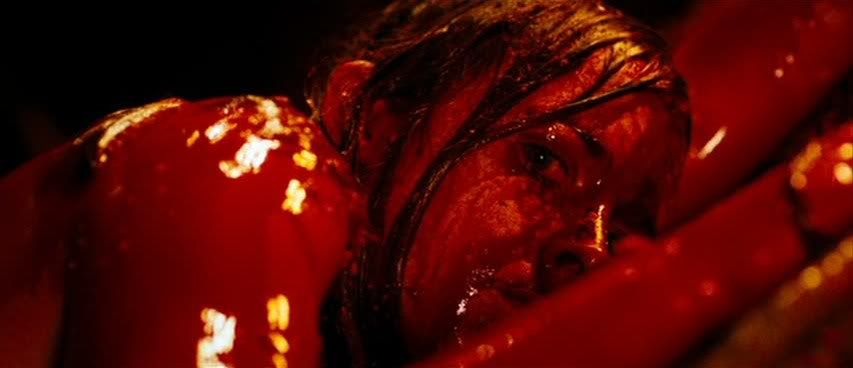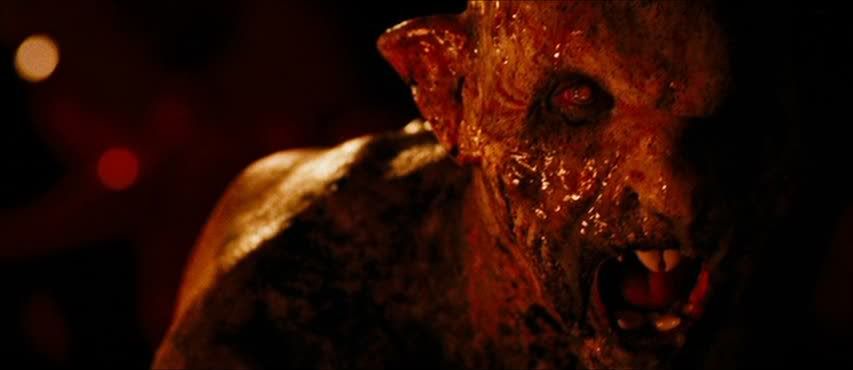
Bleak, creepy and, once its true horror premise is belatedly revealed after a lengthy and patient build-up, absolutely brutal, The Descent is as good as minimal, no-frills horror gets. A group of friends, all young women, meet up for yearly adventures in order to bond despite being spread out across the world, dealing with individual lives and individual tragedies. Their latest trip together is a descent into an unexplored cave system, spelunking and crawling through the tight tunnels. The structure's strictly traditional: some set-up, in which the women's chatter and banter at their staging cabin introduces their relationships and personalities, and then it's off into the caves, where the claustrophobia quickly becomes unbearable. The darkness, the constriction, is intense, and these women, crawling through the caves, often crawl right up to the camera, the lights on their heads creating blinding flashes within the darkness. The frame becomes a series of holes, small irregular patches of light chopped out of the blackness that otherwise surrounds the explorers everywhere. It's nearly overwhelming in the way it forces the audience to feel what the characters feel, to be trapped and lost along with them.
And that's all before, after all this build-up towards a claustrophobic but rather conventional story of being lost and trapped in the dark, all hell breaks loose and things start to get really ugly. Director Neil Marshall is excellent at showing just enough to suggest the horror happening in the dark, without actually showing more than a brief burst of motion here, a geyser of blood there, a frenzied struggle thrashing around in the dark. The editing is brisk and occasionally confusing in its rapid pacing and dizzying shifts in perspective, but there's no denying that Marshall still locates numerous striking, horrifying images within this darkness and confusion, honing in on the bracing moments of anguish and devastation that are splattered throughout the film. It's a visceral film, all about capturing the in-your-face sensations of being surrounded by darkness, hemmed in on all sides and assaulted by mutated monsters intent on devouring any soft flesh that gets in their way.
Before this, though, there's an introduction in which the trauma that will linger over the rest of the film is introduced. In one brief moment, Sarah (Shauna MacDonald) loses both her husband and her daughter and, in a subtle exchange of glances and gestures that she misses but that isn't lost on the audience, Marshall also establishes the unspoken origin of a slow-burning tension that develops between Sarah and her best friend Juno (Natalie Mendoza) and will eventually boil over completely at the harrowing climax. The storytelling is simple, even simplistic, but that's all that's required here: Marshall sets up, very quickly and economically, the minimal conflicts that will serve as a subtextual counterpoint to the more physical horror that explodes in the film's second half.


The rest of the women — Beth (Alex Reid), Rebecca (Saskia Mulder), Sam (MyAnna Buring), Holly (Nora-Jane Noone) — are clustered around this central trauma, creating a realistic group of friends with a naturalistic sense of camaraderie. They mock each other in the way real friends do, goofing around, chatting amiably with rapid-fire patter; one recalls the banter of the women in Quentin Tarantino's Death Proof, albeit without the reflexive cultural namedropping. The film is raw and stripped-down, eventually sending these cheerful, confident women through the grinder. Marshall captures certain powerful images that appear as though glimpsed in passing in the flickering flame of torchlight: a lake of blood from which the heroine emerges glistening and wet, with little nuggets of gristle and bone scattered along her forearms; the little bubbles of blood that spurt out when a blade cuts into flesh; a white, animalistic naked body caught for a second in the glow of a lamp, like an animal frozen in the headlights; the women's frightened faces clustered together in the green haze of a light; a twisted closeup of a mole-like mutant's snarling face, ooze dripping down its rubbery chin.
Once the monsters are introduced, the claustrophobic terror of crawling through tight spaces, being constricted on all sides, is replaced by the bloody, harsh violence of the women's fight against these creatures. They're separated from one another and forced to fend off the monsters' attacks, and as the formula dictates in a movie like this, attrition begins wearing away at the group, quickly dwindling their numbers. It's obvious from the start who the last two standing have to be, the two friends opposed against each other in subtle ways, their friendship strained by the shared trauma of the opening scenes and the subsequent events. The last two women alive become gritty action heroes, wading through blood, armed with blades that they'd once used for climbing and that they now plunge ferociously into the warped bodies of their attackers. Marshall's direction becomes frenzied and over-the-top, depicting the women with their faces and bodies smeared with blood, striking melodramatic action poses as they fight off waves of the monsters. In many ways, it's a jarring disconnect in tone and verisimilitude, a startling left turn from the first half's naturalistic depiction of underground claustrophobia and fear. These are ordinary women, if especially athletic and adventurous ones, and one of them makes a point, early on, of saying that she's not Tomb Raider — which makes the film's late transformation into an action movie adventure not entirely convincing.
Which isn't to say that it isn't peculiarly satisfying regardless. The film's bloody, gory denouement is, despite its out-of-nowhere action movie trappings and jittery editing, a rather exhilarating and horrifying ride. The metaphorical emotional and moral descent that Marshall doubtless intends as a parallel to the physical, literal descent, is never handled as well or developed as fully as the director probably intends, but even that hardly matters. The film's aims and successes are relatively modest, but within its area it excels: it is a movie that shocks the senses and provokes a profound sympathy for its generic characters, who one by one are consumed by this giant hole in the ground and its monstrous denizens.








0Awesome Comments!